RETRACTED: A Soft Computing View for the Scientific Categorization of Vegetable Supply Chain Issues
Abstract
1. Introduction
- A scientific classification that gives a far-reaching perspective on various VSC issues situated in the chain organizes commonly concentrated in the analytical writing (creation, handling, dispersion, and retail). This scientific classification addresses a new and more extensive proposition to distinguish and characterize VSC issues closer to involving SC in the four previously mentioned phases. Furthermore, although some exploration articles have portrayed various VSC issues, their definitions are not brought together and differ from one paper to the next. Along these lines, this scientific categorization additionally addresses a work to bring together and combine meanings of the VSC issues accessible in writing, which addresses a significant origin of data for VSC scientists and specialists working in this area;
- To group the VSC issues according to the SC point of view. This grouping permits VSC issues to be planned into normal classes of issues in the SC area. Hence, we give a system that helps show the likenesses and contrasts among VSC issues, relying upon how they can be displayed according to the SC point of view. According to our observation, in such manner, no order has recently been offered in this manner;
- To lay out many rules for utilizing SC in the VSC domain. These rules intend to assist VSC analysts and professionals in recognizing that VSC issues could be tended to by utilizing SC and the most proper groups of strategies to address them. In this manner, these rules address the principle endeavor to characterize an overall structure to help the model choice issue where the fields of VSC and SC studies;
- To recognize and talk about difficulties and explore open doors in the VSC space, which are coordinated towards more hearty, reasonable, incompatible, and precise SC arrangements that help VSC the board and activity.
2. Related Work
3. The Scientific Categorization of the SC-Based Issues in the Vegetable Supply Chain
3.1. Methodology Followed to Plan the Scientific Classification
3.2. The Organized Overview of Issues
3.3. Pointing out of Vegetable Supply Chain Issues
3.3.1. Creation Issues
- Cruciferous vegetable weight evaluation: This interaction measures cruciferous vegetable weight considering morphological highlights (e.g., length, width, and mass).
- Creation assessment and streamlining: This interaction is focused on the advancement of cruciferous vegetable creation and estimating occasional interest to change the creation. To achieve such points, the creation enhancement is done by checking vital components of cruciferous vegetables, supplements, and vegetable supply, which impact the development of cruciferous vegetables. In the interim, documented records of occasional interest are put away and constantly investigated to decide the most appropriate degrees of creation, relying upon the year and season.
- Crop yield and gathering forecast: This issue is centered around yield assessment to coordinate collecting supply with request and on crop the executives to increment efficiency.
- Crop insurance: This depends on the recognizable proof and analysis of biotics (pervasions, illnesses, and weeds) and abiotics (supplements, water). That is why stress factors influence crop efficiency.
- Climate forecast and water system arrangement: This issue is mostly concerned with weather conditions estimating the ideal utilization of water, which empowers the plan and organization of yield water system booking and arranging.
- Site-explicit supplement arrangement: This depends on the administration of soil quality to figure out which supplements should be provided to keep up with the compound attributes expected for the yield.
- Field checking: This issue is connected with the exact recognizable proof of meadow inventories to separate between the most reasonable sorts for tomatoes purposes.
- Tomato government assistance: This is centered around the example arrangement of the dehydration way of behaving in brushing creatures for investigations of creature nourishment, development, and well-being.
- Tomato growth checking: This depends on the utilization of conduct investigations to recognize early indications of medical problems and advance early negotiation.
3.3.2. Handling Issues
- Request expectation: This issue is concerned with the interest expectation of vegetable necessities to abstain from overloading, overproduction, and over-use of assets. The key thought is to assess the number of vegetables offered to characterize how many unrefined substances should be handled.
- Creation anticipating conveyance: This is focused on creation wanting to match dissemination necessities. This issue is not predetermined by the revenue growth that is expected to be generated by a certain vegetable product.
- The expectation of post-gather losses: This is centered around composition assessments of vegetable deprivation related to the handling techniques completed after collecting unrefined materials coming from the creation phase.
- Vegetable growth industry: This is related to the improvement of the handling innovations expected to change unrefined vegetable varieties into eatable vegetables (e.g., warm, drying, contact cooking, microwave warming, and so on.). These cycles are performed utilizing modern apparatuses.
3.3.3. Dissemination Issues
- Vehicle directing arrangement: This is centered around deciding the ideal course for the conveyance of vegetables under various situation limitations (e.g., fuel accessibility, and so forth).
- Capacity area issue: This issue is concerned with choosing the most reasonable method for putting away vegetables in distribution centers to adapt to everyday interest activities.
- The expectation of inventory network disturbances: This is concerned with the measuring of possible disturbances in the operations of vegetable and their related vegetable losses.
- Timeframe of realistic usability expectation and development: This issue is connected with the estimating of the timeframe of realistic usability in light of information detected during the conveyance interaction.
- Request anticipating: This comprises understanding ways of behaving and estimating client requests created from the retail phase. In this way, it is feasible to improve the conveyance courses and stockroom areas utilized during the dispersion phase.
- Last-mile conveyance: This issue is devoted to the conveyance of vegetables utilizing the nearby street transport organization (last mile) in urban areas.
3.3.4. Retail Issues
- Food and sustenance: This depends on assessing supplement values utilizing the arrangement of vegetable dishes and nutritive evaluation.
- Vegetable utilization and vegetable waste: This issue is related to the distinguishing proof and the forecast of vegetable losses given end clients’ purchasing and store conduct.
- Purchaser interest, insight, and purchasing conduct: This issue is centered around deciding buyer profiles to foresee purchasing ways of behaving and support the board of shop counters.
- Dynamic limiting in light of the sell-by date: The focus here is on automated cost changes in general retailers due to the sell-by date. The idea is to set higher restrictions for things that can be used for the shortest possible time.
- Everyday interest expectation and stock administration: This issue comprises anticipating everyday interest to more readily oversee item stocks at stores.
4. Use of SC Strategy in Vegetable Chain Supply
5. Conclusions
Author Contributions
Funding
Data Availability Statement
Conflicts of Interest
References
- World Population Projected to Reach 9.8 Billion in 2050, and 11.2 Billion in 2100. 2017. Available online: https://www.un.org/development/desa/en/news/population/world-population-rospects-2017.html (accessed on 24 May 2022).
- Misra, N.N.; Dixit, Y.; Al-Mallahi, A.; Bhullar, M.S.; Upadhyay, R.; Martynenko, A. IoT, big data and artificial intelligence in agriculture and food industry. IEEE Internet Things J. 2020, 9, 6305–6324. [Google Scholar] [CrossRef]
- Kacprzyk, J.; Pedrycz, W. Introduction. In Springer Handbook of Computational Intelligence; Springer: Berlin/Heidelberg, Germany, 2014; pp. 1–4. [Google Scholar]
- Bishop, C. Pattern Recognition and Machine Learning; Springer: Berlin/Heidelberg, Germany, 2006. [Google Scholar]
- Kakani, V.; Nguyen, V.H.; Kumar, B.P.; Kim, H.; Pasupuleti, V.R. A critical review on computer vision and artificial intelligence in food industry. J. Agric. Food Res. 2020, 2, 100033. [Google Scholar] [CrossRef]
- Liakos, K.G.; Busato, P.; Moshou, D.; Pearson, S.; Bochtis, D. Machine Learning in Agriculture: A Review. Sensors 2018, 18, 2674. [Google Scholar] [CrossRef] [PubMed]
- Kamilaris, A.; Kartakoullis, A.; Prenafeta-Boldú, F.X. A review on the practice of big data analysis in agriculture. Comput. Electron. Agric. 2017, 143, 23–37. [Google Scholar] [CrossRef]
- Onwude, D.I.; Chen, G.; Eke-Emezie, N.; Kabutey, A.; Khaled, A.Y.; Sturm, B. Recent Advances in Reducing Food Losses in the Supply Chain of Fresh Agricultural Produce. Processes 2020, 8, 1431. [Google Scholar] [CrossRef]
- Saiz-Rubio, V.; Rovira-Más, F. From Smart Farming towards Agriculture 5.0: A Review on Crop Data Management. Agronomy 2020, 10, 207. [Google Scholar] [CrossRef]
- Camaréna, S. Artificial intelligence in the design of the transitions to sustainable food systems. J. Clean. Prod. 2020, 271, 122574. [Google Scholar] [CrossRef]
- Griffis, S.E.; Bell, J.E.; Closs, D.J. Metaheuristics in Logistics and Supply Chain Management. J. Bus. Logist. 2012, 33, 90–106. [Google Scholar] [CrossRef]
- Wari, E.; Zhu, W. A survey on metaheuristics for optimization in food manufacturing industry. Appl. Soft Comput. 2016, 46, 328–343. [Google Scholar] [CrossRef]
- Environmental Sustainability Vision Towards 2030: Achievements, Challenges and Opportunities. Available online: www.yumpu.com/en/document/read/20931680/environmental-sustainability-vision-towards-2030-fooddrinkeurope (accessed on 24 May 2022).
- Digal, L.N.; Ahmadi-Esfahani, F. Market power analysis in the retail food industry: A survey of methods. Aust. J. Agric. Resour. Econ. 2002, 46, 559–584. [Google Scholar] [CrossRef]
- McCorriston, S.; Morgan, C.W.; Rayner, A.J. Price transmission: The interaction between market power and returns to scale. Rev. Agric. Econ. 2001, 28, 143–159. [Google Scholar] [CrossRef]
- McCorriston, S.; Morgan, C.W.; Rayner, A.J. Processing Technology, Market Power and Price Transmission. J. Agric. Econ. 1998, 49, 185–201. [Google Scholar] [CrossRef]
- Lloyd, T.; McCorriston, S.; Morgan, W.; Rayner, A.; Weldegebriel, H. Buyer power in UK food retailing: A ‘first-pass’ test. J. Agric. Food Ind. Organ. 2009, 7, 1–38. [Google Scholar]
- Lloyd, T.; McCorriston, S.; Morgan, C.W.; Rayner, A.J. Food scares, market power and price transmission: The UK BSE crisis. Eur. Rev. Agric. Econ. 2006, 33, 119–147. [Google Scholar] [CrossRef]
- Holloway, G. The Farm-Retail Price Spread in an Imperfectly Competitive Food Industry. Am. J. Agric. Econ. 1991, 73, 979–989. [Google Scholar] [CrossRef]
- Fałkowski, J. Price transmission and market power in a transition context: Evidence from the Polish fluid milk sector. PostCommunist Econ. 2010, 22, 513–529. [Google Scholar] [CrossRef]
- Cavicchioli, D. Detecting Market Power along Food Supply Chains: Evidence and Methodological Insights from the Fluid Milk Sector in Italy. Agriculture 2018, 8, 191. [Google Scholar] [CrossRef]
- Cacchiarelli, L.; Sorrentino, A. Market power in food supply chain: Evidence from Italian pasta chain. Br. Food J. 2018, 120, 2129–2141. [Google Scholar] [CrossRef]
- Furesi, R.; Pulina, P.; Madau, F.A. Potere della distribuzione moderna nelle filiere agroalimentari. Il caso dell’olio d’oliva in Italia. Econ. Agro Aliment. 2013, 1, 123–143. [Google Scholar] [CrossRef]
- Niemi, J.; Xing, L. Market power in the retail food industry: Evidence from Finland. In Proceedings of the 21st Annual IFAMA World Symposium, Frankfurt, Germany, 20–23 June 2011. [Google Scholar]
- Nakajima, T.; Matsui, T.; Sakai, Y.; Yagi, N. Structural changes and imperfect competition in the supply chain of Japanese fisheries product markets. Fish. Sci. 2014, 80, 1337–1345. [Google Scholar] [CrossRef]
- Özertan, G.; Saghaian, S.; Tekgüç, H. Market Power in the Poultry Sector in Turkey. Bogazici J. 2014, 28, 19–32. [Google Scholar] [CrossRef]
- Ozertan, G.; Saghaian, S.H.; Tekgüç, H. Dynamics of Price Transmission and Market Power in the Turkish Beef Sector. Sletme Finans 2015, 30, 53–76. [Google Scholar] [CrossRef]
- Kinnucan, H.W.; Tadjion, O. Theoretical Restrictions on Farm-Retail Price Transmission Elasticities: A Note. Agribusiness 2014, 30, 278–289. [Google Scholar] [CrossRef]
- Meyer, J.; von Cramon-Taubadel, S. Asymmetric Price Transmission: A Survey. J. Agric. Econ. 2004, 55, 581–611. [Google Scholar] [CrossRef]
- Vavra, P.; Goodwin, B. Analysis of Price Transmission along the Food Chain; OECD Food Agriculture and Fisheries Working Papers; OECD Publishing: Paris, France, 2005. [Google Scholar]
- Rezitis, A.N.; Reziti, I. Threshold Cointegration in the Greek Milk Market. J. Int. Food Agribus. Mark. 2011, 23, 231–246. [Google Scholar] [CrossRef]
- Kinnucan, H.W.; Forker, O. Asymmetry in farm-retail price transmission for major dairy products. Am. J. Agric. Econ. 1987, 69, 307–328. [Google Scholar] [CrossRef]
- Serra, T.; Goodwin, B. Price transmission and asymmetric adjustment in the Spanish dairy sector. Appl. Econ. 2003, 35, 1889–1899. [Google Scholar] [CrossRef]
- Chavas, J.; Mehta, A. Price Dynamics in a Vertical Sector: The Case of Butter. Am. J. Agric. Econ. 2004, 86, 1078–1093. [Google Scholar] [CrossRef]
- Ben-Kaabia, M.; Gil, J. Asymmetric price transmission in the Spanish lamb sector. Eur. Rev. Agric. Econ. 2007, 34, 53–80. [Google Scholar] [CrossRef]
- Capps, O.; Sherwell, P. Alternative approaches in detecting asymmetry in farm-retail price transmission of fluid milk. Agribus. Int. J. 2007, 23, 313–331. [Google Scholar] [CrossRef]
- Rezitis, A. Investigating price transmission in the Finnish dairy sector: An asymmetric NARDL approach. Empir. Econ. 2018, 57, 861–900. [Google Scholar] [CrossRef]
- Hallam, D.; Rapsomanikis, G. Transmission of price signals and the distribution of revenues along the commodity supply chains: Review and applications. In Governance, Coordination and Distribution along Commodity Value Chains; Food and Agriculture Organization of the United Nations, Commodities and Trade Division: Rome, Italy, 2006; Available online: https://www.fao.org/3/a1171e/a1171e.pdf (accessed on 24 May 2022).
- Awokuse, T.O.; Wang, X. Threshold Effects and Asymmetric Price Adjustments in U.S. Dairy Markets. Can. J. Agric. Econ. 2009, 57, 269–286. [Google Scholar] [CrossRef]
- Peltzman, S. Prices Rise Faster than They Fall. J. Political Econ. 2000, 108, 466–502. [Google Scholar] [CrossRef]
- Clarke, R.; Davies, S. Market Structure and Price-Cost Margins. Economica 1982, 49, 277–287. [Google Scholar] [CrossRef]
- Schmalensee, R. Inter-industry studies of structure and performance. In Handbook of Industrial Organization; Schmalensee, R., Willig, R., Eds.; Elsevier: Amsterdam, The Netherlands, 1989; pp. 951–1009. [Google Scholar]
- Sheldon, I.; Sperling, R. Estimating the Extent of Imperfect Competition in the Food Industry: What Have We Learned? J. Agric. Econ 2003, 54, 89–109. [Google Scholar] [CrossRef]
- Bakucs, Z.; Falkowski, J.; Fertő, I. Price transmission in the milk sectors of Poland and Hungary. Post-Communist Econ. 2012, 24, 419–432. [Google Scholar] [CrossRef]
- Gardner, B. The farm-retail price spread in a competitive food industry. Am. J. Agric. Econ. 1975, 57, 399–409. [Google Scholar] [CrossRef]
- Ball, L.; Mankiw, N. Asymmetric Price Adjustment and Economic Fluctuations. Econ. J. 1994, 104, 247–261. [Google Scholar] [CrossRef]
- Blinder, A. Inventories and sticky prices: More on the microfoundation of macroeconomics. Am. Econ. Rev. 1982, 72, 334–348. [Google Scholar]
- Ward, R. Asymmetry in Retail, Wholesale, and Shipping Point Pricing for Fresh Vegetables. Am. J. Agric. Econ. 1982, 64, 205–212. [Google Scholar] [CrossRef]
- Levy, D.; Bergen, M.; Dutta, S.; Venable, R. The Magnitude of Menu Costs: Direct Evidence from Large U. S. Supermarket Chains. Q. J. Econ. 1997, 112, 791–824. [Google Scholar] [CrossRef]
- Perloff, J.M.; Karp, L.S.; Golan, A. Estimating Market Power and Strategies; Cambridge University Press: New York, NY, USA, 2007. [Google Scholar]
- Perekhozhuk, O.; Glauben, T.; Grings, M.; Teuber, R. Approaches and methods for the econometric analysis of market power: A survey and empirical comparison. J. Econ. Surv. 2017, 31, 303–325. [Google Scholar] [CrossRef]
- Sexton, R.J.; Zhang, M. An assessment of the impact of food industry market power on U.S. consumers. Agribusiness 2001, 17, 59–79. [Google Scholar] [CrossRef]
- Moro, D.; Paolo, S.; Veneziani, M. Multi-stage market power in the Italian fresh meat industry. In Proceedings of the 2012 AAEA Meeting, Seattle, WA, USA, 12–14 August 2012. [Google Scholar]
- Grau, A.; Hockmann, H. Market power in the German dairy value chain. Agribusiness 2018, 34, 93–111. [Google Scholar] [CrossRef]
- Zavelberg, Y.; Wieck, C.; Heckelei, T. How can differences in German raw milk prices be explained? An empirical investigation of market power asymmetries. In Proceedings of the Agricultural & Applied Economics Association and Western Agricultural Economics Association Annual Meeting, San Francisco, CA, USA, 26–28 July 2015; pp. 1–15. [Google Scholar]
- Sckokai, P.; Soregaroli, C.; Moro, D. Estimating Market Power by Retailers in a Dynamic Framework: The Italian PDO Cheese Market. J. Agric. Econ. 2013, 64, 33–53. [Google Scholar] [CrossRef]
- Salhofer, K.; Tribl, C.; Sinabell, F. Market power in Austrian food retailing: The case of milk products. Empirica 2012, 39, 109–122. [Google Scholar] [CrossRef]
- Hockmann, H.; Vöneki, É. Collusion in the Hungarian Market for Raw Milk. Outlook Agric. 2009, 38, 39–45. [Google Scholar] [CrossRef]
- De Mello, M.; Brandao, A. Measuring the Market Power of the Portuguese Milk Industry. Int. J. Econ. Bus. 1999, 6, 209–222. [Google Scholar] [CrossRef]
- Perekhozhuk, O.; Glauben, T.; Teuber, R.; Grings, M. Regional-Level Analysis of Oligopsony Power in the Ukrainian Dairy Industry. Can. J. Agric. Econ. 2014, 63, 43–76. [Google Scholar] [CrossRef]
- Corts, K. Conduct parameters and the measurement of market power. J. Econ. 1999, 88, 227–250. [Google Scholar] [CrossRef]
- Perloff, J.M.; Shen, E. Collinearity in Linear Structural Models of Market Power. Rev. Ind. Organ. 2012, 40, 131–138. [Google Scholar] [CrossRef][Green Version]
- Aquaculture. 2021. Available online: www.fao.org/documents/card/es/c/cb4850en/ (accessed on 24 May 2022).
- Konovalov, D.A.; Saleh, A.; Efremova, D.B.; Domingos, J.A.; Jerry, D.R. Automatic weight estimation of harvested fish from images. In Proceedings of the 2019 Digital Image Computing: Techniques and Applications (DICTA), Perth, Australia, 2–4 December 2019. [Google Scholar]
- Yang, X.; Zhang, S.; Liu, J.; Gao, Q.; Dong, S.; Zhou, C. Deep learning for smart fish farming: Applications, opportunities and challenges. Rev. Aquac. 2021, 13, 66–90. [Google Scholar] [CrossRef]
- Taskiner, T.; Bilgen, B. Optimization Models for Harvest and Production Planning in Agri-Food Supply Chain: A Systematic Review. Logistics 2021, 5, 52. [Google Scholar] [CrossRef]
- Su, Y.; Xu, H.; Yan, L.J. Support vector machine-based open crop model (SBOCM): Case of rice production in China. Saudi J. Biol. Sci. 2017, 24, 537–547. [Google Scholar] [CrossRef]
- Pantazi, X.; Moshou, D.; Alexridis, T.; Whetton, R.L.; Mouazen, A.M. Wheat yield prediction using machine learning and advanced sensing techniques. Comput. Electron. Agric. 2016, 121, 57–65. [Google Scholar] [CrossRef]
- Sambasivam, G.; Opiyo, G. A predictive machine learning application in agriculture: Cassava disease detection and classification with imbalanced dataset using convolutional neural networks. Egypt. Inform. J. 2021, 22, 27–34. [Google Scholar] [CrossRef]
- Jan, B.; Mahlein, A.K.; Rumpf, T.; Römer, C.; Plümer, L. A review of advanced machine learning methods for the detection of biotic stress in precision crop protection. Precis. Agric. 2015, 16, 1573–1618. [Google Scholar]
- Romero, M.; Luo, Y.; Su, B.; Fuentes, S. Vineyard water status estimation using multispectral imagery from an UAV platform and machine learning algorithms for irrigation scheduling management. Comput. Electron. Agric. 2018, 147, 109–117. [Google Scholar] [CrossRef]
- Traore, S.; Luo, Y.; Fipps, G. Deployment of artificial neural network for short-term forecasting of evapotranspiration using public weather forecast restricted messages. Agric. Water Manag. 2016, 163, 363–379. [Google Scholar] [CrossRef]
- Sirsat, M.; Cernadas, E.; Fernández-Delgado, M.; Barro, S. Automatic prediction of village-wise soil fertility for several nutrients in India using a wide range of regression methods. Comput. Electron. Agric. 2018, 154, 120–133. [Google Scholar] [CrossRef]
- Coopersmith, E.J.; Minsker, B.S.; Wenzel, C.E.; Gilmore, B.J. Machine learning assessments of soil drying for agricultural planning. Comput. Electron. Agric. 2014, 104, 93–104. [Google Scholar] [CrossRef]
- Barrett, B.; Nitze, I.; Green, S.; Cawkwell, F. Assessment of multi-temporal, multi-sensor radar and ancillary spatial data for grasslands monitoring in Ireland using machine learning approaches. Remote Sens. Environ. 2014, 152, 109–124. [Google Scholar] [CrossRef]
- Vinicius, P.; Karam, L.Z.; Pitta, C.S.R.; Cardoso, R.; Da Silva, J.C.C.; Kalinowski, H.J.; Ribeiro, R.; Bertotti, F.L.; Assmann, T.S. In vivo pattern classification of ingestive behavior in ruminants using FBG sensors and machine learning. Sensors 2015, 15, 28456–28471. [Google Scholar]
- Matthews, S.G.; Miller, A.L.; PlÖtz, T.; Kyriazakis, I. Automated tracking to measure behavioural changes in pigs for health and welfare monitoring. Sci. Rep. 2017, 7, 2045–2322. [Google Scholar] [CrossRef] [PubMed]
- Alonso, J.; Villa, A.; Bahamonde, A. Improved estimation of bovine weight trajectories using Support Vector Machine Classification. Comput. Electron. Agric. 2015, 110, 36–41. [Google Scholar] [CrossRef]
- Craninx, M.; Fievez, V.; Vlaeminck, B.; De Baets, B. Artificial neural network models of the rumen fermentation pattern in dairy cattle. Comput. Electron. Agric. 2008, 60, 226–238. [Google Scholar] [CrossRef]
- Erik, H.; Emanuel, R. Big data analytics and demand forecasting in supply chains: A conceptual analysis. Int. J. Logist. Manag. 2018, 29, 2. [Google Scholar]
- Feng, Q.; Shanthikumar, J. How Research in Production and Operations Management May Evolve in the Era of Big Data. Prod. Oper. Manag. 2018, 27, 1670–1684. [Google Scholar] [CrossRef]
- Purandare, H.; Ketkar, N.; Pansare, S.; Padhye, P.; Ghotkar, A. Analysis of post-harvest losses: An Internet of Things and machine learning approach. In Proceedings of the International Conference on Automatic Control and Dynamic Optimization Techniques, Pune, India, 9–10 September 2016; pp. 222–226. [Google Scholar]
- Banga, J.R.; Balsa-Canto, E.; Moles, C.G.; Alonso, A.A. Improving food processing using modern optimization methods. Trends Food Sci. Technol. 2013, 14, 131–144. [Google Scholar] [CrossRef]
- Eneko, O.; Yang, X.S.; Diaz, F.; Onieva, E.; Masegosa, A.D.; Perallos, A. A discrete firefly algorithm to solve a rich vehicle routing problem modelling a newspaper distribution system with recycling policy. Soft Comput. 2017, 21, 1433–7479. [Google Scholar]
- Nasr, N.; Niaki, S.T.A.; Hussenzadek Kashan, A.; Seifbarghy, M. An efficient solution method for an agri-fresh food supply chain: Hybridization of Lagrangian relaxation and genetic algorithm. Environ. Sci. Pollut. Res. 2021, in press. [Google Scholar]
- Hui, Y.Y.; Choy, K.L.; Ho, G.T.S.; Leung, K.H.; Lam, H.Y. A cloud-based location assignment system for packaged food allocation in e-fulfillment warehouse. Int. J. Eng. Bus. Manag. 2016, 8, 1847979016684832. [Google Scholar] [CrossRef]
- Mosallanezhad, B.; Hajiaghaei-Keshteli, M.; Triki, C. Shrimp closed-loop supply chain network design. Soft Comput. 2021, 25, 7399–7422. [Google Scholar] [CrossRef]
- Luangkesorn, K.; Klein, G.; Bidanda, B. Analysis of production systems with potential for severe disruptions. Int. J. Prod. Econ. 2016, 171, 478–486. [Google Scholar] [CrossRef]
- Lestari, F.; Mas’ari, A.; Meilani, S.; Riandika, I.N.; Hamid, A.B.A. Risk Mitigation Via Integrating House of Risk and Probability Impact Matrix in Halal Food Supply Chain. J. Tek. Ind. 2021, 22, 138–154. [Google Scholar] [CrossRef]
- Wang, Y.; Zhao, Y.; Addepalli, S. Remaining Useful Life Prediction using Deep Learning Approaches: A Review. Procedia Manuf. 2020, 49, 81–88. [Google Scholar] [CrossRef]
- Brooks, C.; Parr, L.; Smith, J.M.; Buchanan, D.; Snioch, D.; Hebishy, E. A review of food fraud and food authenticity across the food supply chain, with an examination of the impact of the COVID-19 pandemic and Brexit on food industry. Food Control 2021, 130, 108171. [Google Scholar] [CrossRef]
- Shahbazi, Z.; Byun, Y. A Procedure for Tracing Supply Chains for Perishable Food Based on Blockchain, Machine Learning and Fuzzy Logic. Electronics 2021, 10, 41. [Google Scholar] [CrossRef]
- Feizabadi, J. Machine learning demand forecasting and supply chain performance. Int. J. Logist. Res. Appl. 2022, 25, 119–142. [Google Scholar] [CrossRef]
- Bányai, T. Real-Time Decision Making in First Mile and Last Mile Logistics: How Smart Scheduling Affects Energy Efficiency of Hyperconnected Supply Chain Solutions. Energies 2018, 11, 1833. [Google Scholar] [CrossRef]
- Vasiloglou, M.F.; Mougiakakou, S.; Aubry, E.; Bokelmann, A.; Fricker, R.; Gomes, F.; Guntermann, C.; Meyer, A.; Studerus, D.; Stanga, Z. A Comparative Study on Carbohydrate Estimation: GoCARB vs. Dietitians. Nutrients 2018, 10, 741. [Google Scholar] [CrossRef]
- Eftimov, T.; Korošec, P.; Koroušić Seljak, B. StandFood: Standardization of Foods Using a Semi-Automatic System for Classifying and Describing Foods According to FoodEx2. Nutrients 2017, 10, 542. [Google Scholar] [CrossRef]
- Grainger, M.J.; Aramyan, L.; Logatcheva, K.; Piras, S.; Righi, S.; Setti, M.; Vittuari, A.; Stewart, G.B. The use of systems models to identify food waste drivers. Glob. Food Secur. 2018, 16, 1–8. [Google Scholar] [CrossRef]
- Bonaccorsi, M.; Betti, S.; Rateni, G.; Esposito, D.; Brischetto, A.; Marseglia, M.; Dario, P.; Cavallo, F. ‘HighChest’: An Augmented Freezer Designed for Smart Food Management and Promotion of Eco-Efficient Behaviour. Sensors 2017, 17, 1357. [Google Scholar] [CrossRef]
- Borimnejad, V.; Samani, R. Modeling consumer’s behavior for packed vegetable in “Mayadin management organization of Tehran” using artificial neural network. Cogent Bus. Manag. 2016, 3, 1208898. [Google Scholar] [CrossRef]
- Cene, E.; Karaman, F. Analysing organic food buyers’ perceptions with Bayesian networks: A case study in Turkey. J. Appl. Stat. 2015, 42, 1572–1590. [Google Scholar] [CrossRef]
- CEPS. Digitising Agrifood—Pathways and Challenges. 2019. Available online: www.ceps.eu/ceps-publications/digitisingagrifood (accessed on 24 May 2022).
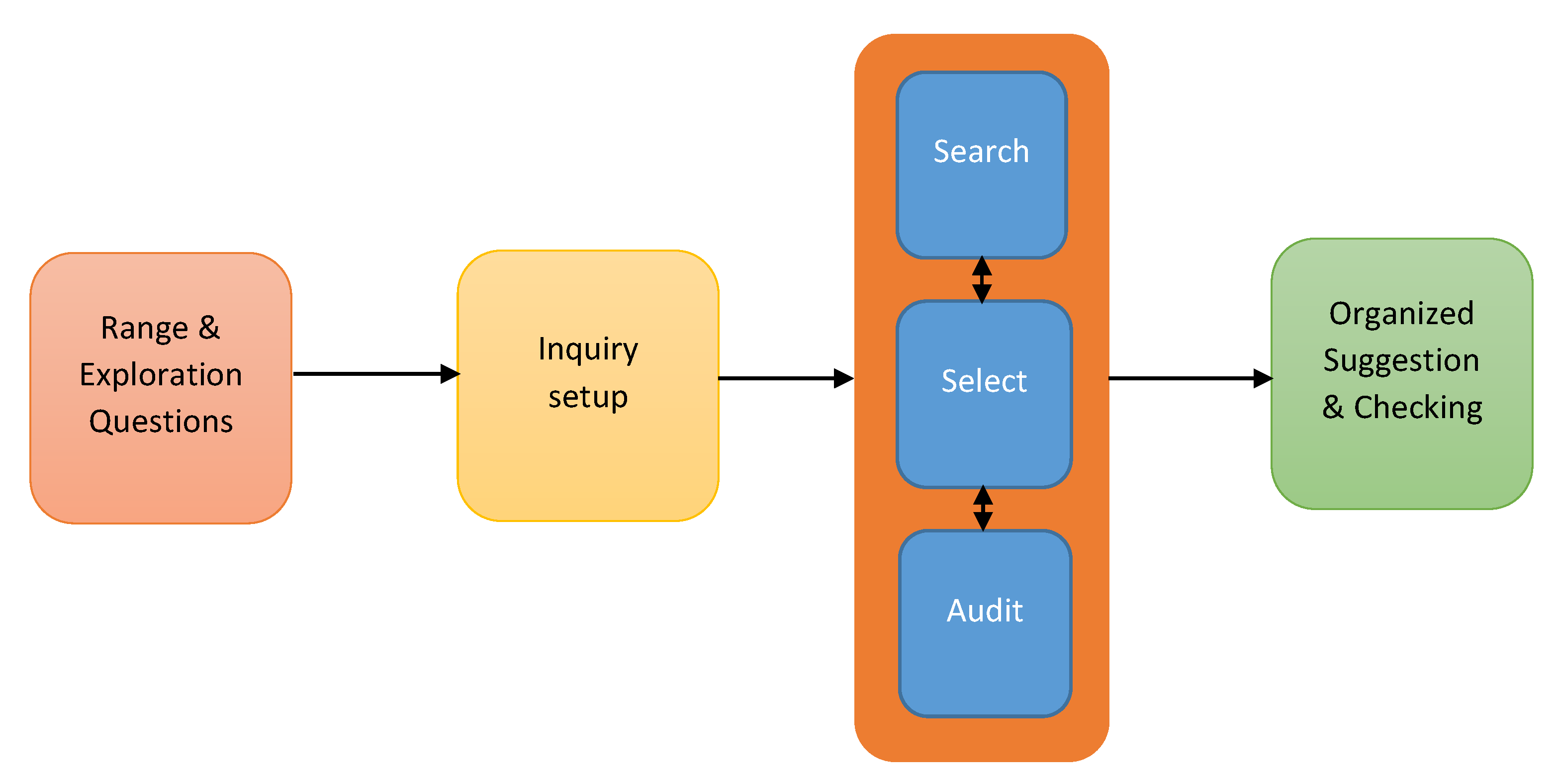
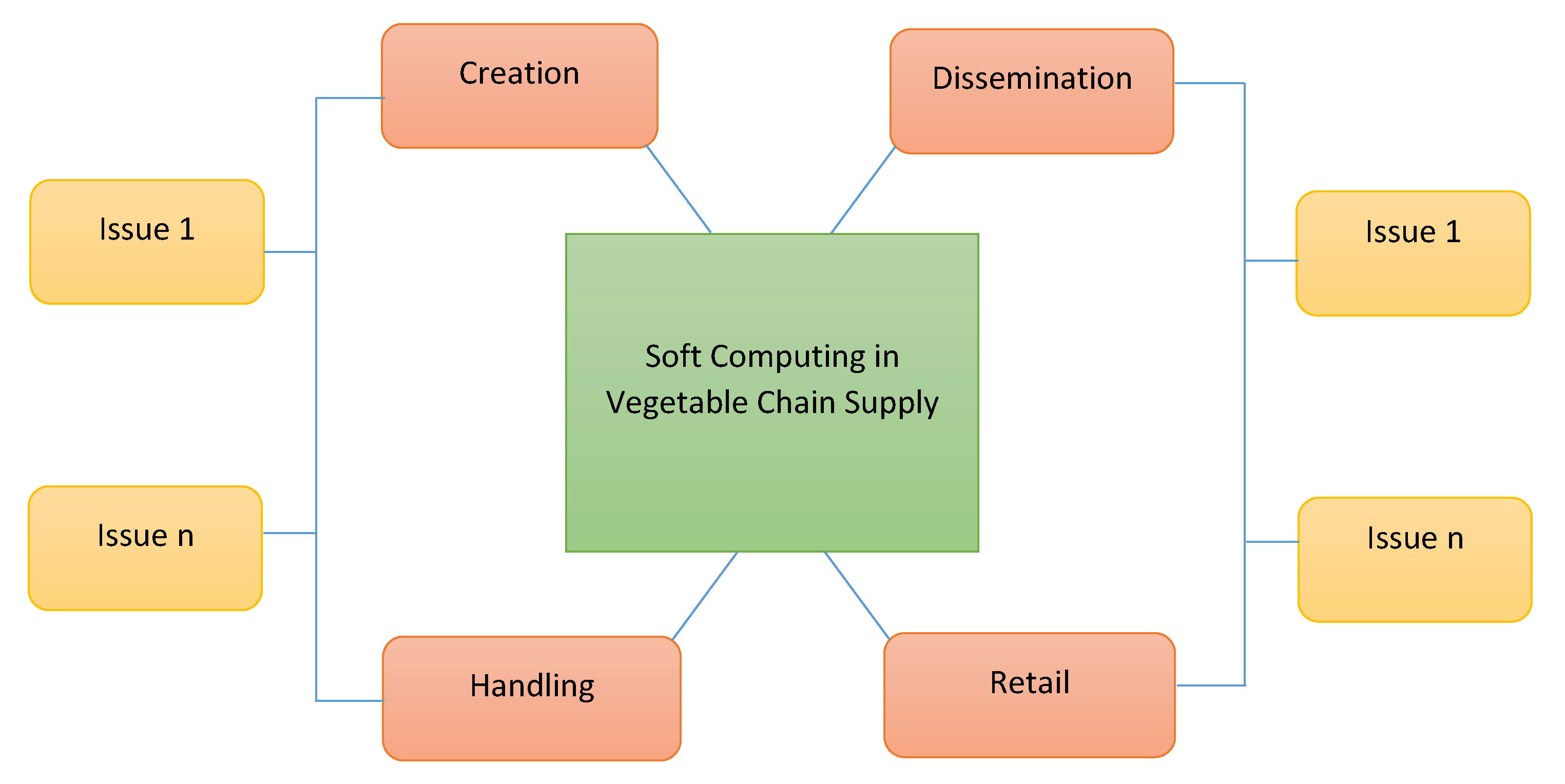
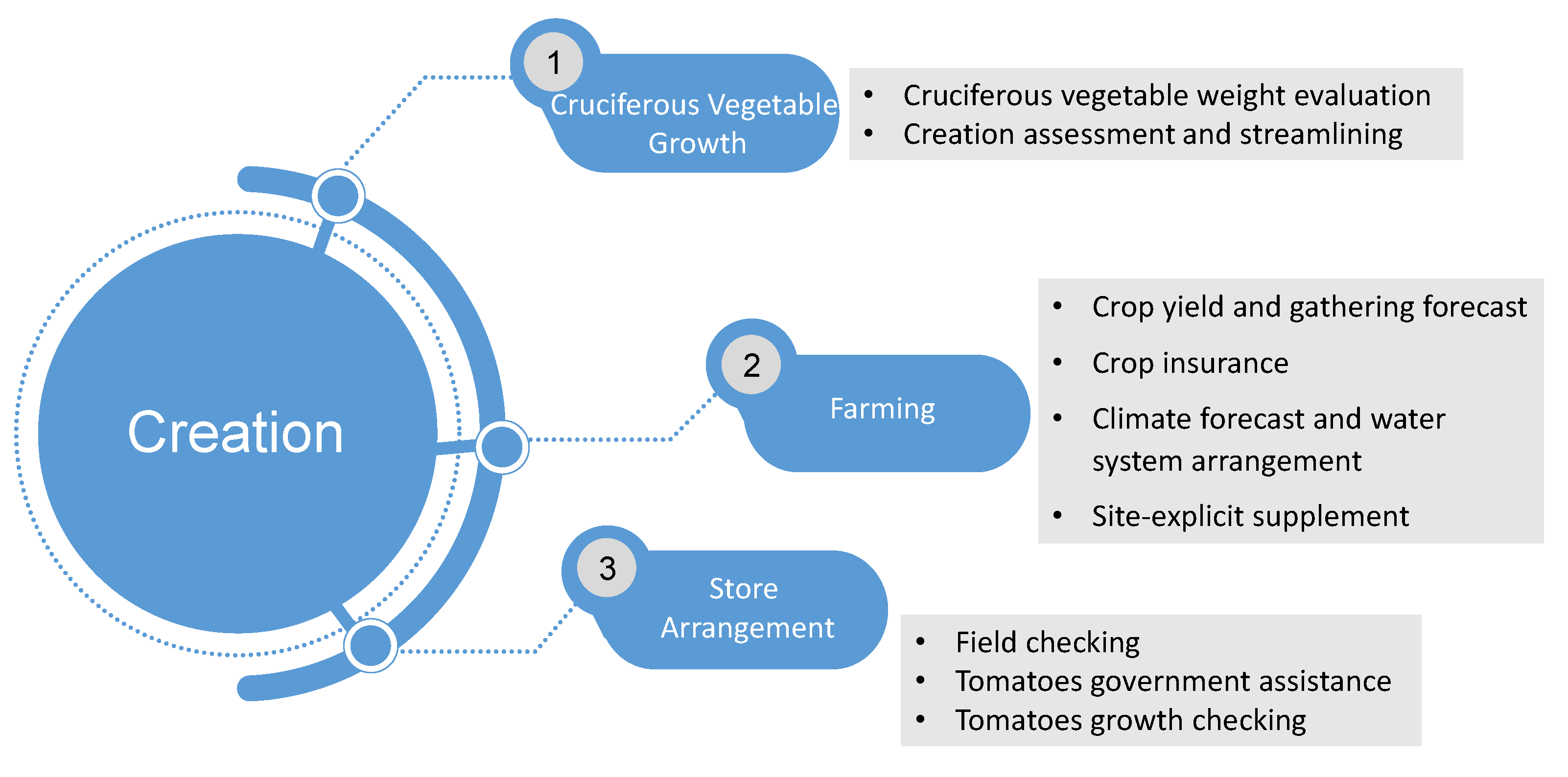
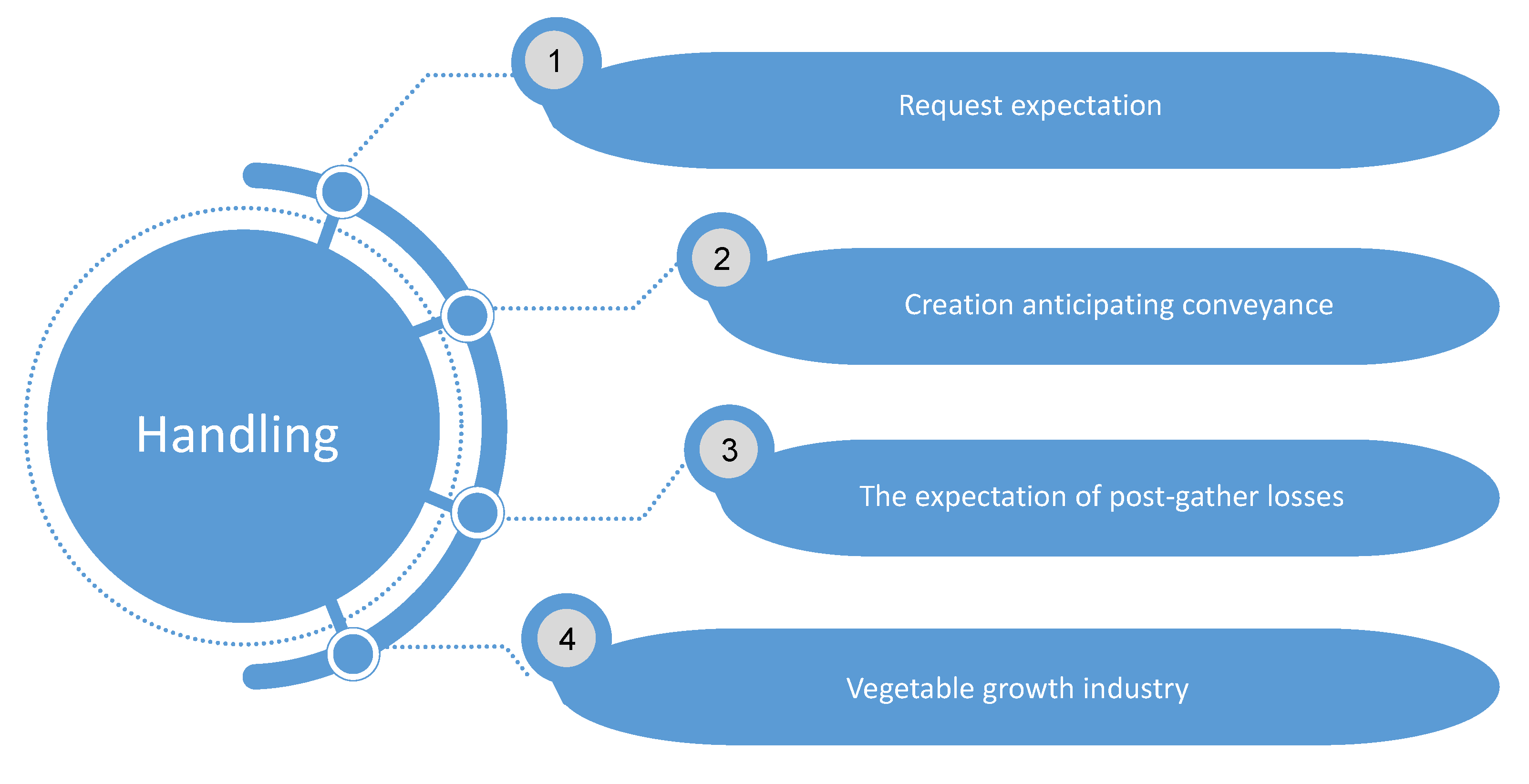

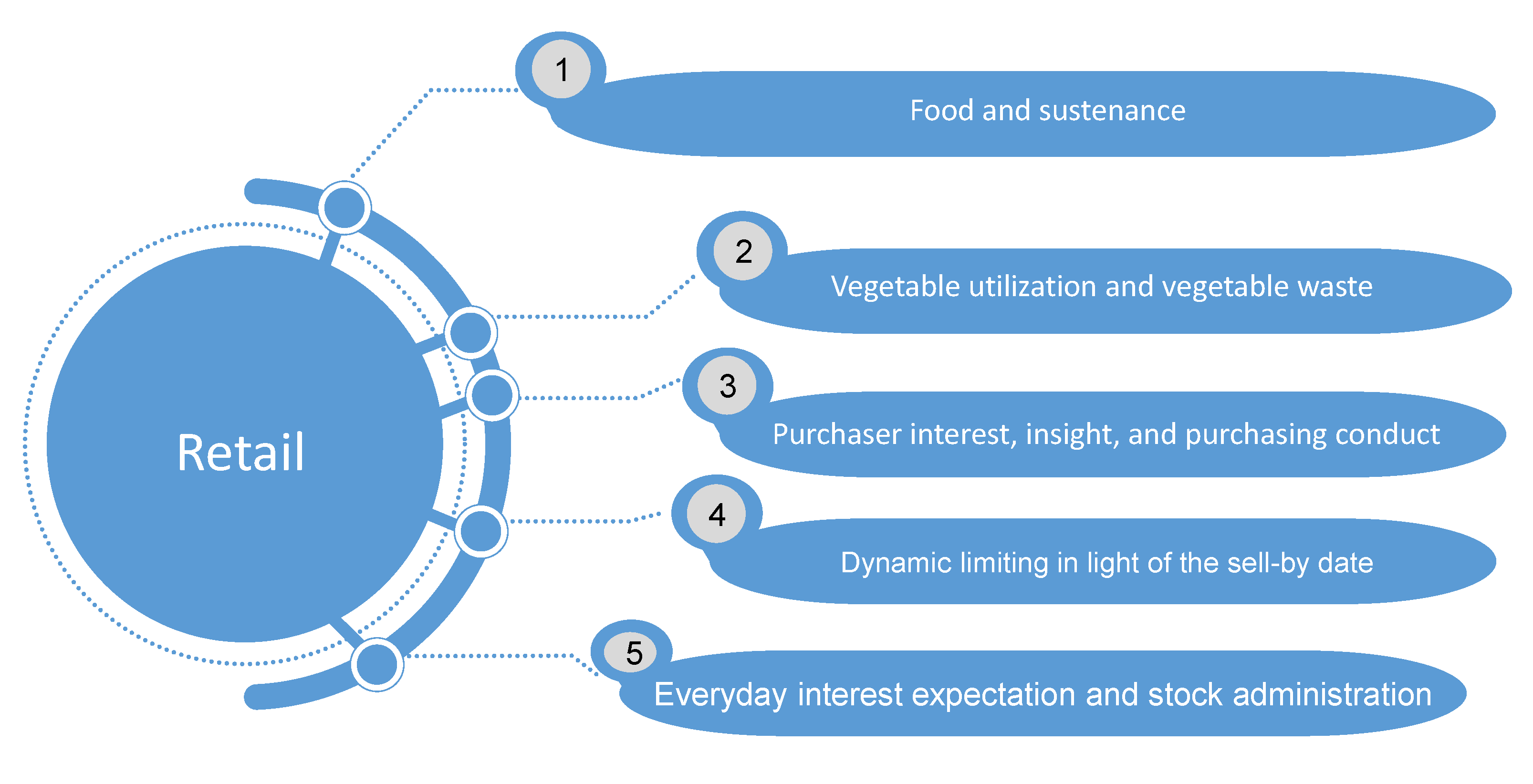

Publisher’s Note: MDPI stays neutral with regard to jurisdictional claims in published maps and institutional affiliations. |
© 2022 by the authors. Licensee MDPI, Basel, Switzerland. This article is an open access article distributed under the terms and conditions of the Creative Commons Attribution (CC BY) license (https://creativecommons.org/licenses/by/4.0/).
Share and Cite
Abbas, R.; Amran, G.A.; Hussain, I.; Ma, S. RETRACTED: A Soft Computing View for the Scientific Categorization of Vegetable Supply Chain Issues. Logistics 2022, 6, 39. https://doi.org/10.3390/logistics6030039
Abbas R, Amran GA, Hussain I, Ma S. RETRACTED: A Soft Computing View for the Scientific Categorization of Vegetable Supply Chain Issues. Logistics. 2022; 6(3):39. https://doi.org/10.3390/logistics6030039
Chicago/Turabian StyleAbbas, Rizwan, Gehad Abdullah Amran, Irshad Hussain, and Shengjun Ma. 2022. "RETRACTED: A Soft Computing View for the Scientific Categorization of Vegetable Supply Chain Issues" Logistics 6, no. 3: 39. https://doi.org/10.3390/logistics6030039
APA StyleAbbas, R., Amran, G. A., Hussain, I., & Ma, S. (2022). RETRACTED: A Soft Computing View for the Scientific Categorization of Vegetable Supply Chain Issues. Logistics, 6(3), 39. https://doi.org/10.3390/logistics6030039







